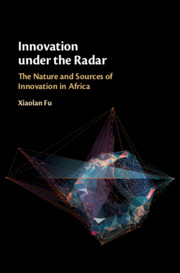Book contents
- Innovation under the Radar
- Innovation under the Radar
- Copyright page
- Dedication
- Contents
- Figures
- Tables
- Foreword
- Acknowledgements
- 1 Introduction
- 2 Innovation in Low-Income Countries
- 3 The Economy of Ghana and Tanzania
- Part I The Nature and Domestic Sources of Innovation in Africa
- Part II The Diffusion of Foreign Innovation into Africa
- Part III Emerging Technologies and Innovation in Africa
- Book part
- References
- Index
1 - Introduction
Published online by Cambridge University Press: 27 November 2020
- Innovation under the Radar
- Innovation under the Radar
- Copyright page
- Dedication
- Contents
- Figures
- Tables
- Foreword
- Acknowledgements
- 1 Introduction
- 2 Innovation in Low-Income Countries
- 3 The Economy of Ghana and Tanzania
- Part I The Nature and Domestic Sources of Innovation in Africa
- Part II The Diffusion of Foreign Innovation into Africa
- Part III Emerging Technologies and Innovation in Africa
- Book part
- References
- Index
Summary
There is a growing recognition that African firms are innovating and these innovations are important to African economies. This chapter provides a general introduction to the book by introducing the broad objectives, the research design and methods as well as the research questions tackled in each of the subsequent chapters of the book. In addition, the chapter presents the structure of the book and summarizes the major findings in each chapter.
- Type
- Chapter
- Information
- Innovation under the RadarThe Nature and Sources of Innovation in Africa, pp. 1 - 15Publisher: Cambridge University PressPrint publication year: 2020



